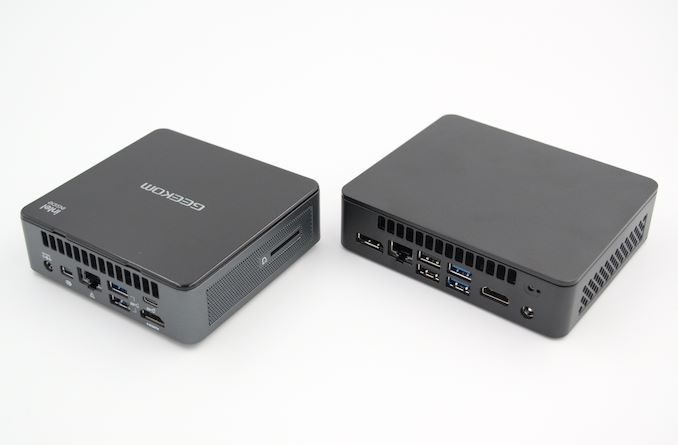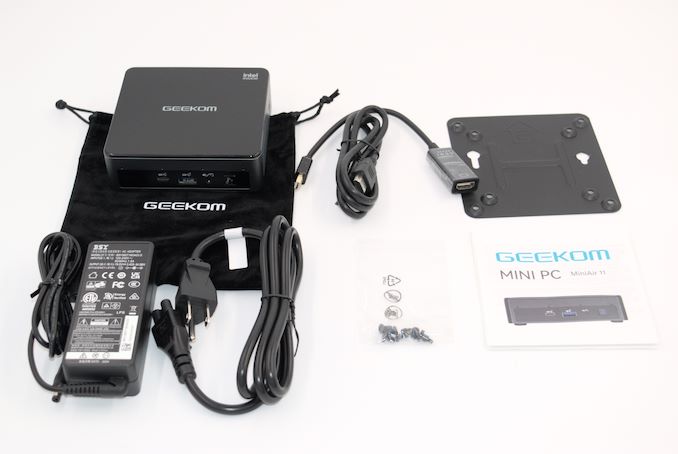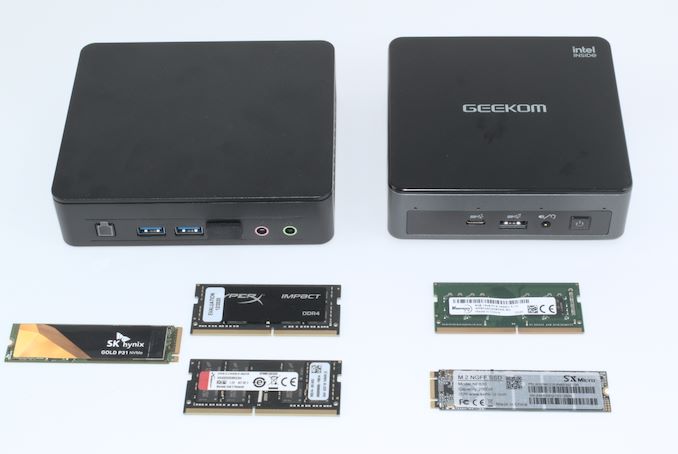- Like
- SHARE
- Digg
- Del
- Tumblr
- VKontakte
- Flattr
- Buffer
- Love This
- Save
- Odnoklassniki
- Meneame
- Blogger
- Amazon
- Yahoo Mail
- Gmail
- AOL
- Newsvine
- HackerNews
- Evernote
- MySpace
- Mail.ru
- Viadeo
- Line
- Comments
- Yummly
- SMS
- Viber
- Telegram
- JOIN
- Skype
- Facebook Messenger
- Kakao
- LiveJournal
- Yammer
- Edgar
- Fintel
- Mix
- Instapaper
- Copy Link
Intel's low-power Tremont microarchitecture has powered a range of products – from the short-lived Lakefield, to Elkhart Lake in the embedded space, and finally, Jasper Lake in the client computing area. A steady stream of notebooks and motherboards / mini-PCs based on Jasper Lake have become available since the introduction of Jasper Lake in early 2021. Given their pricing, ultra-compact form-factor (UCFF) machines based on them offer attractive entry-level options in the NUC domain. With a range of SKUs specified for power consumption numbers ranging from 4.8W up to 25W, the product series lends itself to designs that can be either actively or passively cooled.
Intel's Jasper Lake SKUs are a follow-up to Gemini Lake. Back in 2018, we had reviewed two different Gemini Lake UCFF PCs – the actively cooled June Canyon NUC from Intel, and the passively cooled LIVA Z2 from ECS. For Jasper Lake, we have sourced four different UCFF PCs – two passively cooled systems using 6W TDP processors, and two actively cooled ones using 10W+ TDP processors. Our in-depth look into the two passively-cooled JSLK UCFF PCs – the ECS LIVA Z3 and the ZOTAC ZBOX CI331 nano, was published last week. To round out our Jasper Lake coverage, the review below takes a look at the performance and value proposition of the two actively cooled systems – the Intel NUC11ATKPE and GEEKOM's MiniAir 11.
Introduction and Product Impressions
Intel's Apollo Lake SoCs (Goldmont-based) introduced in 2016 were quickly followed by Gemini Lake (Goldmont Plus) in late 2017. However, the delays related to 10nm manufacturing resulted in a significant gap before the Tremont-based Jasper Lake products made an appearance in early 2021. Compared to Gemini Lake, the new Jasper Lake products have improved CPU performance (Intel claims a 33% uplift) with an updated microarchitecture and larger caches. The integrated GPU is also clocked higher with additional EUs on specific SKUs. On the system front, faster expansion options are available, with up to 8 Gen 3 lanes (compared 6 Gen 2 lanes in Gemini Lake), 14 USB ports (up to 10 Gbps) (compared to 8 ports up to 5 Gbps in Gemini Lake). Jasper Lake also integrates a Wireless-AX MAC, allowing for cost-effective systems with Wi-Fi 6 support. Manufacturers can adopt or take advantage of these features in a varied manner to bring differentiated products into the market.
Similar to our Apollo Lake (Intel Arches Canyon and ECS LIVA Z) and Gemini Lake (Intel June Canyon and ECS LIVA Z2) experiments, we got hold of multiple Jasper Lake UCFF PCs for evaluation. Today's review is focused on the two actively cooled systems – the Intel NUC11ATKPE and GEEKOM MiniAir 11.
A quick comparison of the Intel NUC11ATKPE and the GEEKOM MiniAir 11 reveal the following differentiation aspects:
- Intel Celeron N5095 (TDP of 15W) in the MiniAir 11, compared to Intel Pentium Silver N6005 (TDP of 10W) in the NUC11ATKPE
- Slightly smaller physical footprint for the MiniAir 11
- Mixture of USB Type-C and Type-A ports in the MiniAir 11, compared to only Type-A ports in the NUC11ATKPE
- Availability of SDXC UHS-I Card Reader in the MiniAir 11, not available in the NUC11ATKPE
- Physical DisplayPort output is full-sized in the NUC11ATKPE, while it is mini-DP in the MiniAir 11
- Combo audio jack in the MiniAir 11, while the NUC11ATKPE ships separate audio out and microphone jacks in the front panel
- Intel Wireless-AC 9462 in the NUC11ATKPE, compared to Intel Wireless-AC 7265 in the MiniAir 11
The NUC11ATKPE is primarily priced as a barebones system, but availability of computing systems in general in the recent past has been spotty due to supply chain challenges. This has allowed B2B / B2C retailers like SimplyNUC to place significant premiums for ready-to-ship Atlas Canyon NUCs. Sample this – a barebones NUC11ATKPE has a recommended customer price of around $180 (street price, when available, is around $188). However, SimplyNUC's base price for the Atlas Canyon NUC is currently $449 and comes with 4GB of DDR4 SODIMM and a 256GB M.2 NVMe SSD. One can remove the DRAM and SSD from the configuration, but that doesn't affect the price. Contrast that with the GEEKOM MiniAir 11 – with current discounts, it is priced at $219 (inclusive of taxes) when ordered from their website and $245 (taxes extra) on Amazon. For that price, GEEKOM is bundling in a 256GB M.2 2280 SATA SSD and 1x 8GB DDR4-2666 SODIMM.
The use-cases for both systems are manifold. Intel markets the Atlas Canyon NUCs under the NUC Essentials branding – low-cost, yet effective enough for workloads that do not need extreme processing power. GEEKOM's push is also similar – taking efforts to convey that the system is for casual home and office use, and not for heavy gaming. The systems are also being pushed for applications in retail such as kiosks and digital signage.
While GEEKOM sampled us a retail version of their system package, Intel provided us with a pre-production engineering sample for evaluation. Both systems include a 65W power adapter (19V @ 3.42A) and screws for installing the internal M.2 SSD. The MiniAir 11 package also includes a VESA mount (and associated screws), a HDMI cable, a mini-DP to HDMI adapter cable, a storage bag, and an user guide.
The NUC11ATKPE sample was barebones – we used a SK hynix Gold P31 PCIe 3.0 x4 NVMe SSD in the M.2 slot (though we could have got by with a PCIe 3.0 x2 NVMe SSD such as the WD Blue SN500 also, given that the M.2 slot in the NUC is electrically PCIe 3.0 x2 only). The DRAM option was more tricky. The Jasper Lake platform officially supports DDR4-2933. Having a large number of DDR4-2933 / DDR4-3000 / DDR4-3200 SODIMMs collected (starting from the Skylake days), I was hopeful of getting one of those early high-frequency SODIMMs to operate at DDR-2933 speeds in the NUC11ATKPE. Unfortunately, they all defaulted to DDR4-2400 or DDR4-2666, and the BIOS was not too helpful in terms of allowing modification of DRAM timings. Only recent DDR4-2933+ SODIMMs were able to operate at DDR-2933 in the system – unfortunately, I only had 32GB SODIMMs in hand from the recent batches. In the end, the NUC11ATKPE was outfitted with 2x 32GB DDR4-3200 Kingston HyperX (now, FURY) SODIMMs for a total of 64GB of RAM – higher than the officially specified 32GB maximum memory capacity of the NUC11ATKPE. Fortunately, the system worked flawlessly through our benchmarking routines despite this out-of-spec configuration. The full specifications of the NUC11ATKPE sample as tested are provided in the table below.
| Intel NUC11ATKPE (Atlas Canyon) Specifications (as tested) | |
| Processor | Intel Pentium Silver N6005 Jasper Lake 4C/4T, 2.0 – 3.3 GHz Intel 10nm, 4MB L3, 10W PL1 : 15W / 28s ; PL2 : 25W / 2.44ms |
| Memory | Kingston HyperX KHX3200C20S4/32GX DDR4-3200 SODIMM (operating at DDR4-2933) 19-21-21-39 @ 2933 MHz 2×32 GB |
| Graphics | Intel UHD Graphics (32EU @ 450 – 900 MHz) |
| Disk Drive(s) | SK hynix Gold P31 SHGP31-1000GM-2 (1 TB; M.2 2280 PCIe 3.0 x4 NVMe SSD, operating at x2) (SK hynix 128L 4D TLC; SK hynix Cepheus ACNT038 Controller) |
| Networking | 1x GbE RJ-45 (Realtek RTL8168/8111) Intel Wireless AC-9462 (1×1 802.11ac – 433 Mbps) |
| Audio | Realtek ALC269 (3.5mm Audio Jacks in Front Panel) Digital Audio and Bitstreaming Support over HDMI and DisplayPort Outputs |
| Video | 1x HDMI 2.0b 1x DisplayPort 1.4 |
| Miscellaneous I/O Ports | 2x USB 3.2 Gen 1 Type-A (Front) 2x USB 3.2 Gen 2 Type-A (Rear) 2x USB 2.0 Type-A (Rear) |
| Operating System | Windows 11 Enterprise (22000.778) |
| Pricing | (Street Pricing on July 12th, 2022) US $188 (barebones) US $468 (as configured) |
| Full Specifications | Intel NUC11ATKPE Specifications |
The GEEKOM MiniAir 11 review sample came with only one of the memory slots occupied (1x 8GB DDR4-2666 SODIMM). A 256GB SXMicro NF830 M.2 SATA SSD is also included. The retail sample comes with Windows 11 Pro pre-installed, but as customary, we wiped out the drive and installed our own copy for evaluation purposes. The full specifications of the GEEKOM MiniAir 11 sample as tested are provided in the table below.
| GEEKOM MiniAir 11 Specifications (as tested) | |
| Processor | Intel Celeron N5095 Jasper Lake 4C/4T, 2.0 – 2.9 GHz Intel 10nm, 4MB L3, 15W PL1 : 10W / 28s ; PL2 : 20W / 2.44ms |
| Memory | Shenzhen Wodposit Tech. WPBS26D408SWE-8G DDR4-2666 SODIMM 19-19-19-43 @ 2666 MHz 1×8 GB |
| Graphics | Intel UHD Graphics (16EU @ 450 – 750 MHz) |
| Disk Drive(s) | SXMicro NF830 (256 GB; M.2 2280 SATA III;) (Micron 64L 3D TLC; Silicon Motion SM2259XT Controller) |
| Networking | 1x GbE RJ-45 (Realtek RTL8168/8111) Intel Wireless AC-7265 (2×2 802.11ac – 867 Mbps) |
| Audio | Realtek ALC269 (3.5mm Combo Audio Jack in Front Panel) Digital Audio and Bitstreaming Support over HDMI and DisplayPort Outputs |
| Video | 1x HDMI 2.0b 1x mini-DisplayPort 1.4 |
| Miscellaneous I/O Ports | 1x USB 3.2 Gen 2 Type-A (Front) 1x USB 3.2 Gen 1 Type-C (Front) 2x USB 3.2 Gen 1 Type-A (Rear) 1x USB 3.2 Gen 2 Type-C (Rear) |
| Operating System | Ships with Windows 11 Pro, Tested with Windows 11 Enterprise (22000.739) |
| Pricing | (Street Pricing on July 12th, 2022) US $245 (as configured, with OS) |
| Full Specifications | GEEKOM MiniAir 11 Specifications |
The chassis of both systems is made of polycarbonate except for the metal plate held by four screws on the underside. The top of the MiniAir 11 is glossy and attracts smudges and fingerprints, while the NUC11ATKPE has a matte finish.
A closer look at the NUC11ATKPE case and internal pictures are available in the gallery below. The thickness of the system is such that a simple thermal pad affixed to the underside of the chassis is sufficient to cool down the installed SSD. Another interesting aspect of the NUC11ATKPE is the absence of any sort of LED indicator in the front panel, other than the power button itself. Instead, there is a front panel header (behind the flexible covering) that contains pins to drive LEDs for storage activity and other statuses.
The gallery above provides a look at the chassis design of the GEEKOM MiniAir 11. It also includes disassembly photos – disassembly is straightforward and required if there is ever a need to update the internal SSD or RAM. A thermal pad on top of a metal block on the underside of the chassis makes up the thermal protection for the installed SSD.
In the next section, we take a look at the system setup and follow it up with a detailed platform analysis.



















